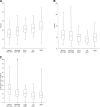Isolated hyperglycemia at 1 hour on oral glucose tolerance test in pregnancy resembles gestational diabetes mellitus in predicting postpartum metabolic dysfunction
- PMID: 18356402
- PMCID: PMC2453676
- DOI: 10.2337/dc08-0126
Isolated hyperglycemia at 1 hour on oral glucose tolerance test in pregnancy resembles gestational diabetes mellitus in predicting postpartum metabolic dysfunction
Abstract
Objective: Gestational impaired glucose tolerance (GIGT), defined by a single abnormal value on antepartum 3-h oral glucose tolerance test (OGTT), is a metabolically heterogeneous disorder. Indeed, the antepartum metabolic phenotype of women with a single abnormal value at 1 h during the OGTT (1-h GIGT) resembles that of women with gestational diabetes mellitus (GDM), whereas GIGT at 2 or 3 h (2/3-h GIGT) is similar to normal glucose tolerance (NGT). Thus, we hypothesized that 1-h GIGT would be associated with the same adverse outcomes as GDM, i.e., increased infant birth weight and postpartum metabolic dysfunction.
Research design and methods: A total of 361 women underwent an antepartum glucose challenge test (GCT) and a 3-h OGTT, assessment of obstetrical outcome at delivery, and metabolic characterization by OGTT at 3 months postpartum. The antepartum GCT/OGTT identified five study groups: GDM (n = 97), 1-h GIGT (n = 28), 2/3-h GIGT (n = 34), abnormal GCT NGT (abnormal GCT with NGT on OGTT) (n = 128), and normal GCT NGT (normal GCT with NGT on OGTT) (n = 74).
Results: Caesarian section rate was higher in women with 1-h GIGT, but birth weight did not differ significantly between the non-GDM groups (P = 0.1978). At 3 months postpartum, glycemia (area under the glucose curve) progressively increased across the groups from normal GCT NGT to abnormal GCT NGT to 2/3-h GIGT to 1-h GIGT to GDM (P < 0.0001), while both insulin sensitivity (IS(OGTT)) and beta-cell function (insulinogenic index/homeostasis model assessment of insulin resistance [HOMA-IR]) progressively decreased (P = 0.002 and P < 0.0001, respectively). The strongest independent negative predictors of insulinogenic index/HOMA-IR were GDM (t = -4.1, P < 0.0001) and 1-h GIGT (t = -3.8, P = 0.0002).
Conclusions: Like GDM, 1-h GIGT is associated with postpartum glycemia, insulin resistance, and beta-cell dysfunction.
Figures

References
-
- Kjos SL, Buchanan TA: Gestational diabetes mellitus. N Engl J Med 341:1749–1756, 1999 - PubMed
-
- Crowther CA, Hiller JE, Moss JR, McPhee AJ, Jeffries WS, Robinson JS, Australian Carbohydrate Intolerance Study in Pregnant Women (ACHOIS) Trial: Effect of treatment of gestational diabetes on pregnancy outcomes. N Engl J Med 352:2477–2486, 2005 - PubMed
-
- Kim C, Newton KM, Knopp RH: Gestational diabetes and the incidence of type 2 diabetes: a systematic review. Diabetes Care 25:1862–1868, 2002 - PubMed
-
- Kim C. Herman WH, Vijan S: Efficacy and cost of postpartum screening strategies for diabetes among women with histories of gestational diabetes. Diabetes Care 30:1102–1106, 2007 - PubMed
Publication types
MeSH terms
Grants and funding
LinkOut - more resources
Full Text Sources
Medical

